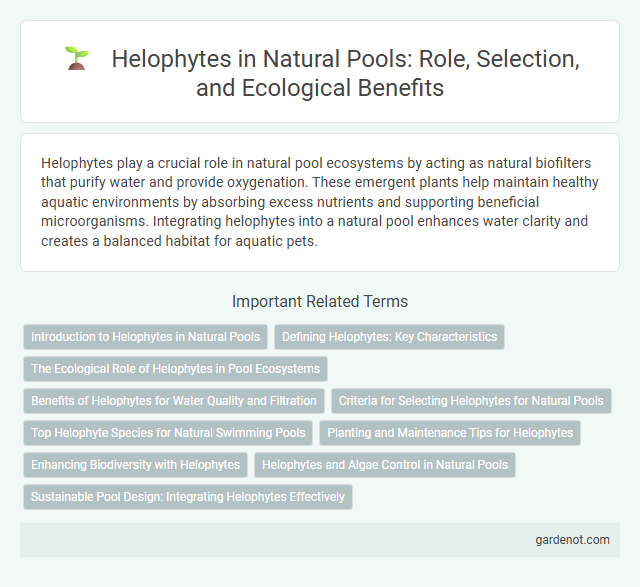Helophytes play a crucial role in natural pool ecosystems by acting as natural biofilters that purify water and provide oxygenation. These emergent plants help maintain healthy aquatic environments by absorbing excess nutrients and supporting beneficial microorganisms. Integrating helophytes into a natural pool enhances water clarity and creates a balanced habitat for aquatic pets.
Introduction to Helophytes in Natural Pools
Helophytes are essential plants in natural pools, thriving in shallow waters where they filter pollutants and support aquatic ecosystems. These emergent macrophytes absorb nutrients through their roots, improving water clarity and enhancing biodiversity. Incorporating helophytes in natural pool designs promotes sustainable water purification and creates habitats for wildlife.
Defining Helophytes: Key Characteristics
Helophytes are aquatic plants adapted to grow in waterlogged soils or shallow water, characterized by their robust root systems and emergent stems. These plants play a crucial role in natural pool ecosystems by filtering impurities and enhancing water clarity through their nutrient uptake. Their ability to thrive in wet environments makes them essential for maintaining ecological balance and supporting biodiversity in natural water habitats.
The Ecological Role of Helophytes in Pool Ecosystems
Helophytes play a crucial ecological role in natural pool ecosystems by improving water quality through nutrient uptake and pollutant filtration. These emergent aquatic plants provide habitat and breeding grounds for diverse microorganisms, insects, and amphibians, supporting biodiversity. Their root systems stabilize sediment and promote oxygenation of the water, enhancing overall ecosystem health and resilience.
Benefits of Helophytes for Water Quality and Filtration
Helophytes play a crucial role in natural pools by improving water quality through effective filtration and nutrient absorption. Their extensive root systems trap sediments and promote beneficial microbial activity that breaks down pollutants and excess nutrients. This natural biofiltration process enhances water clarity and supports a balanced aquatic ecosystem without the need for chemical treatments.
Criteria for Selecting Helophytes for Natural Pools
Helophytes selected for natural pools must exhibit strong root systems for effective nutrient absorption and water filtration, ensuring clear and healthy water. Tolerance to varying water levels and adaptability to local climate conditions are crucial for long-term sustainability and ecosystem balance. Native species often provide optimal habitat support for wildlife while minimizing maintenance and chemical inputs.
Top Helophyte Species for Natural Swimming Pools
Top helophyte species for natural swimming pools include common reed (Phragmites australis), bulrush (Schoenoplectus spp.), and cattail (Typha latifolia), which efficiently filter water through their extensive root systems. These plants not only enhance water clarity by absorbing nutrients and pollutants but also provide essential habitat for aquatic wildlife. Incorporating diverse helophyte species maximizes ecological balance and supports sustainable, chemical-free water purification in natural swimming pools.
Planting and Maintenance Tips for Helophytes
Helophytes thrive in natural pools by rooting in submerged soil or gravel zones where they filter water and provide habitat for aquatic life. Planting helophytes requires selecting species suited to the pool's depth and sunlight exposure, ensuring they are spaced to prevent overcrowding and promote healthy growth. Regular maintenance involves trimming dead or decaying foliage, controlling invasive species, and monitoring water quality to sustain the helophytes' natural filtration role.
Enhancing Biodiversity with Helophytes
Helophytes play a crucial role in enhancing biodiversity within natural pools by providing habitat and food sources for diverse aquatic and terrestrial species. These emergent plants improve water quality through nutrient uptake and filtration, fostering a balanced ecosystem. Their complex root systems create microhabitats that support invertebrates, amphibians, and beneficial microorganisms, boosting overall ecological resilience.
Helophytes and Algae Control in Natural Pools
Helophytes play a crucial role in natural pools by filtering nutrients and reducing algae growth through their root systems, which absorb excess phosphates and nitrates. These plants create a balanced ecosystem that limits algae proliferation, enhancing water clarity and quality without chemical intervention. Efficient helophyte zones combined with proper pool design promote sustainable algae control and support biodiversity in natural swimming environments.
Sustainable Pool Design: Integrating Helophytes Effectively
Helophytes play a crucial role in sustainable pool design by naturally filtering water through their extensive root systems, which absorb nutrients and reduce algae growth. Integrating species such as bulrushes and reeds enhances water clarity while promoting biodiversity, creating a balanced aquatic ecosystem. Effective placement and layering of helophytes within the regeneration zone optimize pollutant removal, ensuring long-term ecological stability in natural pools.
Helophyte Infographic

 gardenot.com
gardenot.com